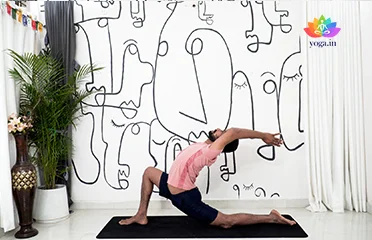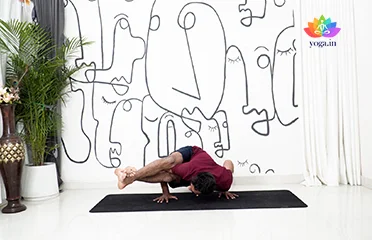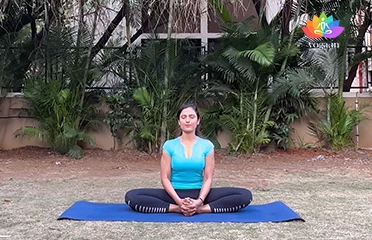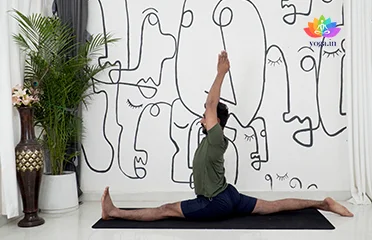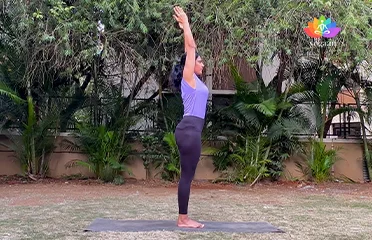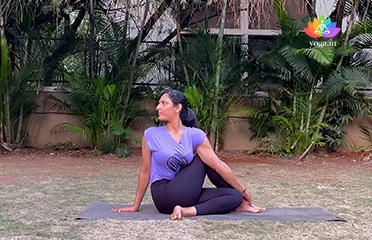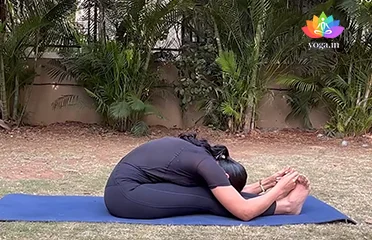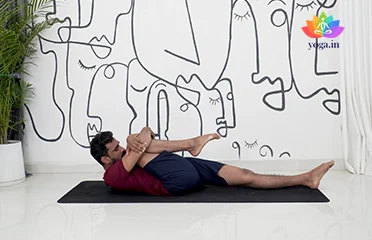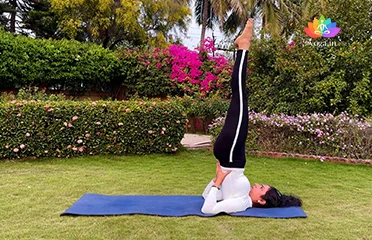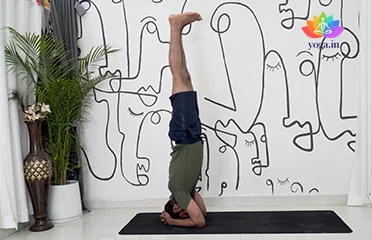Anjaneyasana (Crescent Moon Pose)
आंजनेयासन / Crescent Moon Pose
The Sanskrit name is derived from Anjane (आंजने) meaning Hanuman, [�K]
Astavakrasana (Eight-Angle Pose)
अष्टवक्रासन / Eight-Angle Pose
The sanskrit name is derived from ashta (अष्ट) meaning eight, Vakra [�K]
Bhadrasana (Gracious Pose | Butterfly Po
भद्रासन / Gracious Pose | Butterfly Pose
The Sanskrit name is derived from Bhadra (भद्रा) meaning gracious, [�K]
Hanumanasana (Monkey Pose)
हनुमानासन / Monkey Pose
The Sanskrit name is derived from the Hindu God -Hanuman (हनुमान) [�K]
Hastapadasana (Hand to Foot Pose)
हस्तपदासन / Hand to Foot Pose
The sanskrit name is derived from hasta (हस्त) means hands, pada (पदा) [�K]
Matsyendrasana (Lord of the Fishes Pose)
मत्स्येन्द्रासन / Lord of the Fishes Pose
The name Matsyendrasana is derived from the Sanskrit words Matsya (मत्स्य) [�K]
Paschimottanasana (Seated Forward Bend)
पश्चिमोत्तानासन / Seated Forward Bend
The Sanskrit name is derived from three sanskrit words: Paschima (पश्चिमा) [�K]
Pawanmuktasana (Wind Release Pose)
पवनमुक्तासन / Wind Release Pose
The Sanskrit name is derived from Pawan (पवन) meaning wind or gas, Mukta [�K]
Sarvangasana (Shoulderstand)
सर्वाङ्गासनI / Shoulderstand
The Sanskrit name is derived from Sarva (सर्वाङ्ग) meaning all, [�K]
Sirsasana (Headstand)
शीर्षासन / Headstand
The Sanskrit name is derived from Sirsa (शीर्ष) meaning head and asana [�K]
- 1
- 2
How Yoga Can Help Cure Impotency:
Impotency, also known as erectile dysfunction (ED), is the inability to achieve or maintain an erection sufficient for sexual intercourse. Yoga can help manage and alleviate the symptoms of impotency by improving blood circulation, reducing stress, and enhancing overall physical and mental well-being. Through specific postures, breathing exercises, and meditation, yoga can support sexual health and function.
Understanding Impotency:
Impotency is a condition where a man finds it difficult to achieve or maintain an erection during sexual activity. It can be caused by physical, psychological, or a combination of factors. Impotency can significantly impact a person’s quality of life, affecting self-esteem and intimate relationships. It is a common issue that many men experience at some point in their lives.
Yoga’s Role in Relieving Impotency:
Yoga can play a crucial role in alleviating the symptoms of impotency through various practices. Gentle asanas (postures) can improve blood flow to the pelvic region, pranayama (breathing exercises) can reduce stress and anxiety, and meditation can enhance mental clarity and emotional stability. Together, these practices can help restore sexual function and improve overall health.
Key Factors Contributing to Impotency:
Several factors can contribute to the development of impotency, including:
- Physical Health Issues: Conditions like diabetes, high blood pressure, and heart disease.
- Hormonal Imbalances: Low levels of testosterone or other hormonal issues.
- Psychological Factors: Stress, anxiety, and depression can impact sexual performance.
- Lifestyle Choices: Poor diet, lack of exercise, smoking, and excessive alcohol consumption.
- Medications: Certain medications can have side effects that lead to ED.
- Age: The risk of impotency increases with age due to various physiological changes.
Symptoms of Impotency:
Common symptoms of impotency include:
- Difficulty Achieving an Erection: Struggling to get an erection firm enough for intercourse.
- Difficulty Maintaining an Erection: Losing an erection during sexual activity.
- Reduced Sexual Desire: A noticeable decrease in interest in sexual activities.
- Emotional Distress: Feelings of embarrassment, guilt, or frustration related to sexual performance.
Treatment of Impotency through Yoga and Pranayama:
Yoga and pranayama can be highly effective in managing impotency. Some beneficial practices include:
Specific Yoga Poses:
- Bhujangasana (Cobra Pose): Enhances blood flow to the pelvic region and strengthens the lower back.
- Setu Bandhasana (Bridge Pose): Improves blood circulation and strengthens the pelvic muscles.
Pranayama Exercises:
- Anulom Vilom (Alternate Nostril Breathing): Balances the mind and reduces anxiety.
- Bhramari (Bee Breath): Calms the mind and reduces stress levels.
Diet for Impotency:
A balanced diet can help manage impotency. Recommendations include:
- Leafy Greens: Spinach, kale, and other greens improve blood flow.
- Nuts and Seeds: Almonds, walnuts, and flaxseeds boost heart health.
- Lean Proteins: Chicken, fish, and legumes support overall health.
- Fruits: Watermelon, berries, and bananas enhance circulation.
- Whole Grains: Oats, brown rice, and quinoa provide sustained energy.
- Hydration: Drink plenty of water to stay hydrated and support circulation.
Caution for Impotency:
While practicing yoga for impotency, it is essential to:
- Avoid Overexertion: Practice at a gentle pace to prevent strain.
- Be Mindful of Pain: Stop immediately if any pose causes discomfort or pain.
- Consult a Healthcare Provider: Before starting any new exercise regimen, especially if you have underlying health conditions.
Contraindications for Impotency:
Individuals with certain health conditions should:
- Avoid Intense Yoga Practices: Vigorous exercises might exacerbate symptoms.
- Steer Clear of Certain Poses: Inversions and poses that compress the abdomen may increase discomfort.
- Seek Professional Guidance: Consult a yoga therapist or healthcare professional for personalized recommendations.


